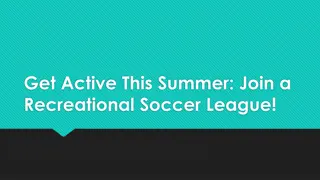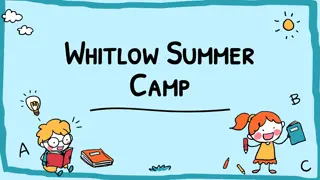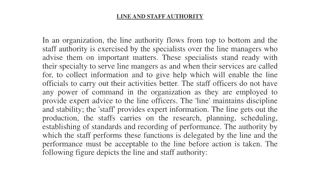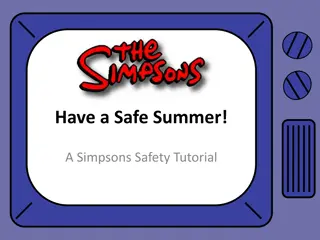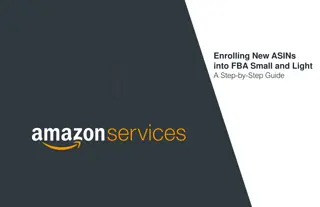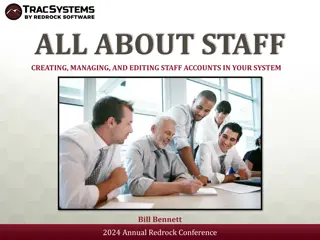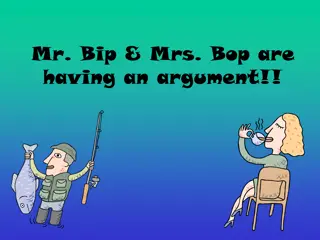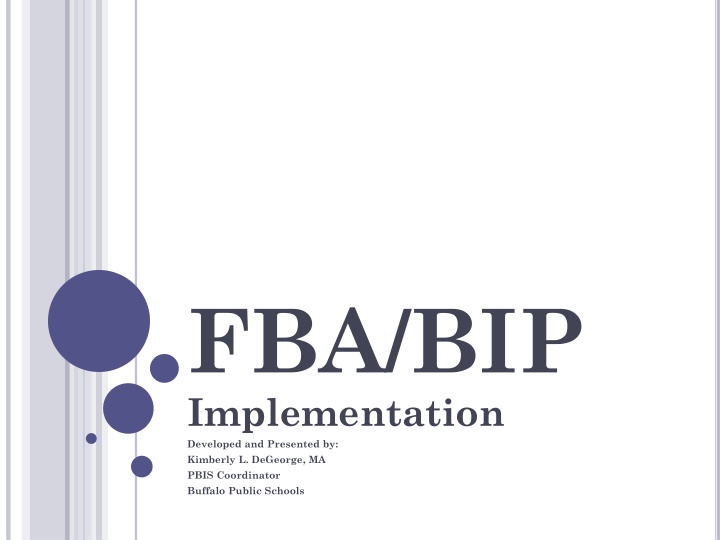
Positive Behavior Intervention Plans and Implementation Overview
Explore the development and implementation of Positive Behavior Intervention Plans (PBIP) by Kimberly L. DeGeorge, MA, PBIS Coordinator at Buffalo Public Schools. This presentation is based on work by experts from Portland State University. Learn about the process, strategies, and tools involved in supporting students with behavior challenges through interventions like Check-in/Check-out and Daily Progress Reports.
Download Presentation

Please find below an Image/Link to download the presentation.
The content on the website is provided AS IS for your information and personal use only. It may not be sold, licensed, or shared on other websites without obtaining consent from the author. If you encounter any issues during the download, it is possible that the publisher has removed the file from their server.
You are allowed to download the files provided on this website for personal or commercial use, subject to the condition that they are used lawfully. All files are the property of their respective owners.
The content on the website is provided AS IS for your information and personal use only. It may not be sold, licensed, or shared on other websites without obtaining consent from the author.
E N D
Presentation Transcript
FBA/BIP Implementation Developed and Presented by: Kimberly L. DeGeorge, MA PBIS Coordinator Buffalo Public Schools
The following presentation is based in part on work by: Chris Borgmeier, PhD cborgmei@pdx.edu Sheldon Loman, PhD sheldon.loman@pdx.edu Portland State University
TAKE THE PRE-TEST Complete the pink sheet (directions are on it!) No names About 10 minutes No cheating!
Positive behavior intervention plans define changes in the behavior of those who will implement the plan. A behavior intervention plan describes what we will do differently.
HOW DOES THIS WORK? You have a student who you feel needs some support: request for assistance to the SST More than 20% - check Tier 1 strategies Low level Tier 2 intervention, such as CICO Progress monitoring (using DPR card) Next level Tier 2 intervention, such as SAIG group Progress monitor (using DPR card with group specific goals)
Check-in/Check-out Lunch B Student:_____________________ Date:_________________________ Respect Following Classroom Rules 0 1 2 0 1 2 0 1 2 0 1 2 0 1 2 0 1 2 0 1 2 0 1 2 School-Ready Teacher Initials Period 1 0 1 2 0 1 2 0 1 2 0 1 2 0 1 2 0 1 2 0 1 2 0 1 2 0 1 2 0 1 2 0 1 2 0 1 2 0 1 2 0 1 2 0 1 2 0 1 2 0 1 2 0 1 2 Period 2 Period 3 Period 4 5E-5L 6E: Lunch 6L L3 0 1 2 Period 7 Period 8 Total Points CICO Signature______________________ Parent Signature_______________________________
Example Daily Progress Report NAME:______________________ DATE:__________________ Teachers please indicate YES (2), SO-SO (1), or NO (0) regarding the student s achievement to the following goals. 1 st block 2nd block 3 rd block 4 th block EXPECTATIONS 2 1 0 2 1 0 2 1 0 2 1 0 Be Safe Use your words Use deep breathing 2 1 0 2 1 0 2 1 0 2 1 0 Be Respectful Keep arm s distance Use #2 voice level when upset 2 1 0 2 1 0 2 1 0 2 1 0 Be Responsible Ask for breaks Self-monitor with DPR Total Points Teacher Initials Adapted from Grant Middle School STAR CLUB
THEN Referred for a Problem Solving Team meeting Prior to meeting .. BIP developed at the meeting Progress monitoring -easy way (DPR) -other way .
WHENDO I NEEDA BIP FORASTUDENT? Behavior interferes with learning of student or others Behavior results in suspensions Class managed? Individually managed?
COMPLEX VERSUS BRIEF FBA/BIP Brief Complex 1) For special education students (student has an IEP) 2) All pages of FBA and BIP required. 3) Considered a CSE evaluation and requires prior written notice and consent 1) For general education students (no IEP) 2) First page of FBA and first page of BIP 3) Page 2 and 3 of BIP may be helpful to you, but not required
WHATAREMY RESPONSIBILITIESASA TEACHER? Be aware of students you teach who have BIP s Implement the BIP components that apply in a classroom setting Work with the SST in their gathering of data to develop the FBA Work with the Problem Solving Team and/or CSE to develop the BIP Record and report on outcome data IF student has BIP on IEP . You are legally responsible 408.
WHATIF I AMTHE CASE MANAGER? Include feedback on BIP in IEP Direct for mandated report-outs Review need for BIP at annual review Indicate if change needs to be made on IEP BIP s can be altered without CSE action A new FBA or changes to FBA requires re-eval BIP can be dropped from IEP at AR or at an amendment meeting
Ship Wheels products REALITY CHECK Building the ship while we are sailing .. Because of CSE processes ..FBA/BIP exists and has existed before PBIS System was in place. We may need to paddle backwards and forwards at the same time ... Sail boats products
HERESWHEREWEVEBEEN Overall processes for FBA/BIP Understanding of PBIS Systems and best practices as they relate to FBA/BIP Overall responsibilities for FBA/BIP
HERESWHEREWEAREGOINGNEXT Theory and development of Function- Based BIP How to progress monitor How to understand/find/complete CSE documents
????????????????????? http://ts1.mm.bing.net/th?id=H.4961766394432422w=103h=103c=8pid=3.1qlt=90rm=2
FBA FORM SST members will gather data and information to complete most of this form As a team, you will decide on a replacement behavior that matches the function of the problem behavior FBA used to build a BIP that is efficient and effective because it is function based (conducting FBA s doubles the success rate of an intervention!).
ONEBEHAVIORATATIME Why? How to choose? Process/iterations
DEFINING PROBLEM BEHAVIOR OBSERVABLEAND MEASURABLE Examples Out of seat and walking around the room touching other student s things Hits with hands and kicks peers Steals valuable items from peers Reports seeing monsters Non-Examples Hyperactive Aggressive Delinquent Psychotic Irresponsible Arrives to class late 75% of the time
BEHAVIOR INTERVENTION PLANS FBA BIP The most important purpose of conducting FBA is to inform the development of comprehensive Behavior Intervention Plans that directly address the FUNCTION of student behavior
FUNCTION-BASED INTERVENTIONS Start with FBA results = Hypothesis Statement Hypothesis Statement should include a detailed and specific description of: Targeted Routine (Setting Event) Antecedents triggering behavior Problem Behavior Maintaining Consequence/Outcome of Problem Behavior Function of Behavior
ANALYZINGTHE SUMMARYOF BEHAVIOR Read over the Hypothesis Statement, but pay special attention to the Function identified for the problem behavior The Function of Behavior will be central to identifying effective interventions (BIP) to address: Antecedent (Setting and Trigger) Behaviors to Teach & Consequences
STARTW/ HYPOTHESIS STATEMENTFROM FBA Targeted Routine Antecedent Maintaining Consequence & Function Problem Behavior
FBA: SUMMARYOF BEHAVIOR Targeted Routine Maintaining Consequence & Function Antecedent Problem Behavior FUNCTION FUNCTION is where student behavior intersects with the environment Function = Learning Student learns . When (A), if I (B), then (C) Function = how I benefit so I keep doing B
COMPETING BEHAVIOR PATHWAY Completed from FBA
SOTHISISWHATWEWANT. Desired Behavior Natural Consequence Targeted Routine Antecedent Maintaining Consequence & Function Problem Behavior Alternate Behavior But start with the Alternate Behavior? Why can t we go right to the Desired Behavior?
WHYTHE ALTERNATE BEHAVIOR? WHYCAN TWEGORIGHTTOTHE DESIRED BEHAVIOR? 4. The student is going to need to gain the math skills before being able to do this like peers 3. Look how different this is from what s happening now 1. This is what we re asking the student to do. Complete math problem Success, another problem Given double digit addn problems Sent to back table (escape task) Math class Throws a Tantrum Raise hand & ask for break 2. This is what the student wants now. 5. So in the meantime we use the alternate behavior
FUNCTION BASED INTERVENTIONS When generating interventions we use Function to develop ideas to change A, B & C Targeted Routine Maintaining Consequence & Function Antecedent Problem Behavior FUNCTION Function should guide selection of alternative/ replacement behaviors
UNDERSTANDING ALTERNATE/ REPLACEMENT BEHAVIORS Alternate Behaviors are: an immediate attempt to reduce disruption & potentially dangerous behavior in the classroom Take some of the pressure off the teacher designed to actively begin breaking the student s habit of using problem behavior to meet their needs, by replacing it with a more acceptable alternate behavior
ESSENTIAL CHARACTERISTICSOFA REPLACEMENT / ALTERNATE BEHAVIOR An appropriate Replacement Behavior: Serves the same function as the problem behavior Is easier to do and more efficient than the problem behavior Alternate Behaviors require less physical effort & provide quicker, more reliable access to desired outcome/response than problem behavior Is socially acceptable
WHICHOFTHE FOLLOWINGARE APPROPRIATE REPLACEMENT BEHAVIORS? Leslie is 12, has severe intellectual disabilities, does not use words, and hits her head. Head hitting is maintained by adult attention during work periods. Start w/ the Function Which is the best Replacement Behavior hide under her desk and be ignored sign for more to another student take completed work up to show the teacher move to sit by another student Use picture communication system to request teacher help 1. Serve same Function ? Does it provide adult attn? 2. Is Behavior easier to do than problem behavior? 3. Is Behavior socially acceptable?
WHICHOFTHE FOLLOWINGARE APPROPRIATE REPLACEMENT BEHAVIORS? Jason is nine and cries when asked to do difficult tasks. The crying is maintained by avoiding or escaping difficult tasks. Start w/ the Function Possible Replacement Behaviors: More rewards for doing tasks Asking for an easier task/ worksheet Asking to play w/ his Gameboy Requesting adult attention Asking to have soda after tasks are done 2. Is Behavior easier to do than problem behavior? 1. Serve same Function ? Does it provide escape/ avoid? 3. Is Behavior socially acceptable?
COMPETING BEHAVIOR PATHWAY: ALTERNATIVE BEHAVIOR Example: Jason (from previous example) Antecedent Problem Behavior Consequence Avoid/Escape Difficult Task Asked to do difficult tasks Crying Asking for an easier task/ worksheet NOTE: This antecedent is not specific enough
IDENTIFYINGTHE ALTERNATE BEHAVIOR Yes or No? Why? What are the critical features of an Alternate Behavior? 1. Serve same Function? Does it provide escape from difficult task? 2. Is Behavior easier to do than problem behavior ? 3. Is Behavior socially acceptable?
ACTIVITY 2 With a partner go through each of the Competing Behavior Pathway options in Pre-Test #2 Yes or No & Why
BEHAVIOR SUPPORT PLANNING Identify a range of interventions that address prevention (A), teaching (B) & consequences (C) You may not use them all, but it is good to identify multiple interventions options across A, B & C
TEACHINGBEHAVIOR Teaching Identify skill(s) to teach Dual focus when teaching behavior Alternate Behavior Desired Behavior 1) ALWAYS START with the Alternative Behavior -FIRST - Teach the alternate behavior you identified in Competing Behavior Pathway -Teaching = Review & practice regularly -THEN teach the Desired Behavior -this may be something to focus on immediately, or only after the student is fluent with the alternative behavior
TEACHINGBEHAVIOR Don t assume student already has Alternate Behavior in their skill set Develop an observable definition of behavior Identify examples & non-examples 2) Model/ Lead/ Test 3) Schedule Review & Practice of Skill/ Behavior Regularly 4)
TEACHING BEHAVIOR - DEXTER What are the critical features of Teaching Interventions? 1. First teach the Alternate Behavior Yes or No? Does Alt. Beh.: a) Serve same Function? b) Is it Easier? c) Socially acceptable? Why?
EXAMPLE: TEACHING BEHAVIOR A B C behavior. Teach Dexter to raise his hand & ask for a break, engaging in negative instead of *By teaching Dexter an easier alternate behavior to get what he wants, we re making the problem behavior Inefficient. Dexter will need frequent practice, precorrections, and prompts to help him get in the habit of using the alternate behavior
ACTIVITY 3 -QUINN With a partner go through each of the Teaching Behavior options in Pre-Test #2 Yes or No & Why
ANTECEDENT INTERVENTIONS Prevent & Prompt
FUNCTION BASED INTERVENTIONS When generating interventions we use Function to develop ideas to change A, B & C Targeted Routine Maintaining Consequence & Function Antecedent Problem Behavior FUNCTION Function should guide selection of prevention strategies Function should guide selection of alternative/ replacement behaviors
ANTECEDENT INTERVENTIONS Preventing Problem Behavior Prevention- Change the trigger that sets off the problem behavior Examine the Antecedent & Function of the Problem Behavior Change the antecedent so student will no longer need to use problem behavior (make the problem behavior Irrelevant) The best choices for Antecedent changes: (A) (B) Directly address the identified antecedent must address the function the problem behavior is serving 1. 2.
ANTECEDENT INTERVENTIONSDIRECTLY ADDRESSTHEIDENTIFIEDANTECEDENT Antecedent = Asked to read aloud in class Potential options that more directly address the antecedent Do not ask student to read aloud in class Give student passage in advance to practice pre-reading Let student read 1 sentence directions they are familiar with, instead of entire paragraphs from the text Non-examples (do not directly address antecedent) Move student closer to the teacher Attend a counseling group about anger management Check-in with teacher before reading group Now, why is Function important?
ANTECEDENTINTERVENTIONSMUST ADDRESSTHEFUNCTIONTHEPROBLEM BEHAVIORSERVES Antecedent = Asked to read aloud in class + Function = Avoid any public presentation (not about reading difficulty; more related to social anxiety) Does the Intervention address the Function of Behavior Do not ask student to read aloud in class (or respond publicly) Give student passage in advance to practice pre-reading Let student read 1 sentence directions they are familiar with, instead of entire paragraphs from the text Does the Intervention address the function of behavior?
ANTECEDENT INTERVENTIONS Critical features of Antecedent Interventions to prevent the Problem Behavior? Does the intervention directly address: a) the antecedent? b) the Function of the problem behavior? Yes or No? Why?
ANTECEDENT INTERVENTIONS A B C multi-digit multiplication & division problems, let s give him an assignment he can be more successful with (e.g. 4 single digit mult/div problems for every 1 multi-digit problem) Instead of giving Dexter the class math assignment of *By changing A, we can PREVENTDexter s need to engage in negative behavior, making it Irrelevant






